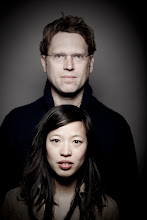08.22.2009 Japanese vending machine product of the day: Suntory Dekavita C. This packaging definitely stands out. Love the heavy brown glass bottle and its shape. The sharp yellow and red labels are eye catching. Fizzy energy drink that tastes like vitamin C. Also contains vitamin B, folic acid niacin, vitamin P, and a little caffeine, too.
 Today we took a pilgrimage to the Takao area, a mountaintop section of Northwest Kyoto. It's famous for its trio of mountaintop temples: Jingo-ji, Saimyo-Ji and Kozan-Ji. It's a popular destination for its autumn foliage and springtime cherry blossoms, but the summertime is really lush with greenery. The air is filled with the buzzing of cicadas and croaking of frogs. And it's a cool getaway from the heat and humidity of Central Kyoto. Just under a 50 minute bus ride from Kyoto Station. We stopped at the Makino bus stop, which stops right in front of a restaurant run by a woman and her mother. Neither of them speak English, nor is there an English menu, but we managed to order some zaru soba and braised pumpkin before our hike up the mountain. There aren't many English signs in this area. Exploring Kyoto: On Foot in the Ancient Capital comes in handy again, with English directions and descriptions and the Kanji translation of the names of the temples.
Today we took a pilgrimage to the Takao area, a mountaintop section of Northwest Kyoto. It's famous for its trio of mountaintop temples: Jingo-ji, Saimyo-Ji and Kozan-Ji. It's a popular destination for its autumn foliage and springtime cherry blossoms, but the summertime is really lush with greenery. The air is filled with the buzzing of cicadas and croaking of frogs. And it's a cool getaway from the heat and humidity of Central Kyoto. Just under a 50 minute bus ride from Kyoto Station. We stopped at the Makino bus stop, which stops right in front of a restaurant run by a woman and her mother. Neither of them speak English, nor is there an English menu, but we managed to order some zaru soba and braised pumpkin before our hike up the mountain. There aren't many English signs in this area. Exploring Kyoto: On Foot in the Ancient Capital comes in handy again, with English directions and descriptions and the Kanji translation of the names of the temples.Kiyotaki River The Takaobashi bridge. To the left, the area is crowded with restaurants and inns overlooking the river, open only in the fall.

 Jingo-Ji The beginning of many stairs to the top of the mountain to rid ourselves of bad karma. At the top, you can purchase clay disks, called kawarakenage, which you are to toss down the valley, taking all your bad karma with them. This is a Buddhist Temple, founded by Kukai - the founder of Shingon Buddhisim- in 781 A.D.
Jingo-Ji The beginning of many stairs to the top of the mountain to rid ourselves of bad karma. At the top, you can purchase clay disks, called kawarakenage, which you are to toss down the valley, taking all your bad karma with them. This is a Buddhist Temple, founded by Kukai - the founder of Shingon Buddhisim- in 781 A.D.

One of many restaurants closed for the season

Entrance to Jingo-Ji



Bell tower


Main Hall (Kondo) The interior is impressive, painted in a bright vermilion orange red. Houses a healing buddha, Yakushi Nyorai, carved from a single piece of wood. Thought to be brought here over 1200 years ago. It's one of many of Japan's National Treasures stored in Jingo-Ji. During the Golden Week in early May, the treasures are aired for the public.


The clay disks, kawarakenage

The valley where we watched our discs sail to the bottom carrying our bad karma down with them.

prayer wheel
Saimyo-Ji This became another one of our favorite spots in Kyoto. It's a small, fine little temple. Founded in 824 A.D. by Chisen, who was one of the ten disciples of Kukai. Again, the interior of the main building is impressive. In this building there are enshrined Japan's National Treasures: the main statue of this temple, which is Shakanyorai and a statue of Kannon, having 1,000 hands.










A break at Kiyotaki River

Had we known, we would have brought our swimsuits. But this was a nice cold soak for our tired feet after climbing so many stairs.
 Kosan-Ji (774 A.D.) The only building extant from this temple complex is Sekisui-in, the hermitage of Abbot Myoe. This location is also know as the birthplace of tea in Japan. Zen Master Yosai had travelled to China, brought back the seeds and presented them to Myoe. Myoe grew the plants here, and worked to popularize tea drinking throughout the country. Today it is still a tea plantation.
Kosan-Ji (774 A.D.) The only building extant from this temple complex is Sekisui-in, the hermitage of Abbot Myoe. This location is also know as the birthplace of tea in Japan. Zen Master Yosai had travelled to China, brought back the seeds and presented them to Myoe. Myoe grew the plants here, and worked to popularize tea drinking throughout the country. Today it is still a tea plantation.



Our favorite spot to rest



Scrolls of Frolicking Birds and Animals. Considered by many, the precursor to manga. The scrolls depicts scenes of animals in amusing scenes, analogizing Japanese society of the 12th century. Were thought to be for the priests' amusement.






Downtown Kyoto After a day of temple trekking, we were starving. We had dinner at Omen Nippon. Famous for its ginkaku-ji noodle sets. It's a small, calm place. A nice oasis from all the bustle. We've been many a times to the New York location, as it's one of my favorite Japanese restaurants in the city. The New York Omen is a bit more fancier, but serving much the same, rustic Kyoto-style country cooking.







tiny cute silk figures in storefront window

No comments:
Post a Comment